|
Hiking Gear
Author:
Stan Reents, PharmD
Original Posting:
09/20/2014 06:13 PM
Last Revision: 10/16/2020 06:15 AM
There is a ton of high-quality hiking gear on the market....more than can be summarized here. In this review, I'll share some thoughts, and, give you links to some cool stuff. (please notify us of any broken links, and, feel free to suggest gear we should feature.) 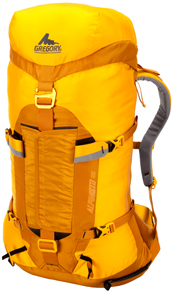 BACKPACKS Get a "size appropriate" backpack that fits comfortably. As with running shoes, backpack design has gotten very sophisticated over the years. A properly-fitted backpack will make a big difference, especially if you are carrying substantial weight. A pack loaded with 30-40 lbs. can really get uncomfortable if it isn't fitted correctly. Give careful consideration to the shoulder straps as that is how the majority of the weight is supported. Go for a short hike with your pack fully-loaded before attempting an all-day hike. The pack should have several external pouches so you can get to some items without having to dig inside. For example, one with a built-in hydration hose is a nice feature. And here is another thought: some packs now have a flexible solar panel on the back for charging your electronics. I bought my backpack at Travel Country, a specialty outdoor gear store in Orlando, FL several years ago. The staff there took time to help me find one that fit my torso. Mine is by Gregory and it is superb. The shoulder straps are wide and cushioned. Other top brands are listed below:
FOOTWEAR: Hiking Boots vs. Hiking Shoes vs. Trail-Running Shoes Obviously, shoes are a critical part of a successful hike. But, there are many choices here. Your options range from hiking boots to hiking shoes to trail-running shoes. While boots might help prevent turning an ankle, they're also the heaviest option. Then again, you'll be wearing them, not carrying them. On the other hand, while trail-running shoes won't give you as much protection, they might be preferable after you've finished the day and need something to wear while lounging around the campfire. Regardless of your choice, as with your backpack, make sure your shoes or boots fit correctly. Wear them long enough before the hike to break them in and/or discover if they give you blisters or not. A single blister on your foot can ruin your hike. Hiking boots: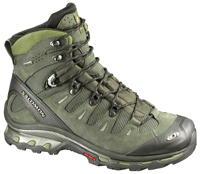 There are many brands of hiking boots. Comfort is probably the most important factor to consider. Here you must weigh flexibility vs. how much support the boot provides. Also consider the design of the sole...ie., will it provide enough traction? Then, what about its water resistance? A Vibram sole with a waterproof, breathable liner is preferred. And, of course, the boot's weight and cost also come into the equation. An independent group picked these as the 7 best hiking boots for men in May 2013. (NOTE: while this table displays them in order, from highest to lowest, the reviewers considered all of them "winners," with Salomon and Asolo as their favorites):
| MANUFACTURER | MODEL | | • Salomon | Quest 4D
**Top Rated** | | • Asolo | Power Matic 200GV | | • Lowa | Renegade | | • Hi-Tec | Altitude IV | | • Merrell | Moab | | • Vasque | Breeze 2.0 GTX | | • Keen | Targhee II |
Hiking shoes: There are also hiking shoes. These are low-cut, like normal shoes, but, have a much sturdier sole than trail-running shoes. Outdoor Gear Lab ranked these as their top 5 in 2013 (in no particular order):
| MANUFACTURER | MODEL | | • The North Face | Hedgehog Guide GTX
**Top Rated** | | • La Sportiva | FC ECO 2.0 | | • Patagonia | Drifter A/C Gore-Tex | | • Keen | Targhee 2 | | • Merrell | Moab Ventilator |

Trail-running shoes: There's no mandate that trail-running shoes are only for runners. Trail-running shoes might be a good choice if you (a) want something lighter than boots, and (b) don't want to wear boots at the end of the day when the hiking is done. Here again, there are lots of choices. Below is a list of 12 favorites by one group from August 2014:
| MANUFACTURER | MODEL | | • Merrell | Barefoot Run
Bare Access Trail GTX | | • Vivobarefoot | Breatho | | • Salomon | Speedcross 3 | | • Pearl Izumi | EM Trail N1 | | • Icebug | Anima2 BUGrip | | • Nike | ZOOM Terra Wildhorse | | • Puma | Faas 300TR | | • Saucony | Xodus 4.0 GTX | | • Adidas | Adistar Raven | | • Adidas | Supernova Riot 5 | | • The North Face | Ultra Guide | | • Salomon | UXR Crossmax 2 |
Here are some links for trail-running shoes: Sandals, Flip-flops: The next thing to consider is what you'll wear once you're done for the day.....ie., do you want to continue to wear heavy hiking boots while relaxing around your campsite? Probably not. But you probably don't want to walk around barefooted either. So, in that case, you might consider also bringing some sandals or flip-flops. Crocs and Teva each offer dozens of styles of sandals and flip-flops.
FOOTWEAR: Socks When it comes to your feet, your socks could be more important than the boots or shoes you wear. Take it from me, a blister on your foot can ruin a hike. 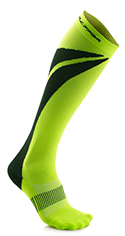 The standard advice has always been to wear non-cotton, moisture-wicking, synthetic or wool socks. What about bamboo? In the summer of 2014, I purchased my first pair of hiking socks made from bamboo fibers. Honestly, these are the most comfortable socks I have ever worn: Ecosox. (Tell Ginny you heard about them here!) Altra Running makes some high-tech socks for marathoners and triathletes that sound intriguing: "cushioned foot beds," "sweat-wicking," "medical grade compression," "ventilation zones," "wide toe boxes".....hmmm, if they're good for marathoners, maybe they might be useful on a long hike, too? If you don't like these green ones (shown here), they also come in white!
CLOTHING Dress for the weather. Different temperatures require different choices: • To stay warm: Avoid cotton. Instead, use multiple layers of garments made of polyester, polypropylene, fleece, or wool. Don't forget a hat made of fleece and, also, gloves. • To stay cool: Wear cotton, or fabrics that wick sweat away. Wear white, or light-colored clothes on hot days. Wear multipurpose pants that zip off into shorts. • To stay dry: Pack a waterproof, breathable rain parka. Patagonia and The North Face are leaders in hiking apparel. Here are some other popular brands: 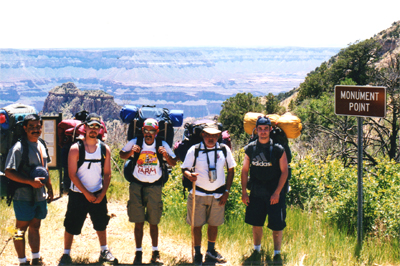 Hats: A hat with a wide brim for sun protection can be a good idea even on a chilly day if it is sunny.
TREKKING POLES Consider a pair of adjustable, collapsible poles with an ergonomically designed handle. On long hikes, or on rocky trails, they can make a difference. A popular brand is LEKI, from the Czech Republic. Readers of Outside magazine chose LEKI poles as best "Outdoor Gear - Accessories" in 2013.
KNIVES, MULTI-TOOLS 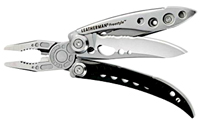 Ya gotta have a knife on a back-country hiking trip, mate! But, here again, the choices are endless. A search for "Leatherman" on REI.com turned up 28 products for that brand alone! Here are some of the leading manufacturers of knives and multi-tools:
WATER FILTER BOTTLES / WATER PURIFICATION SYSTEMS Here, things can get a bit confusing because we must discuss some details of chemistry, microbiology, and technology. The decisions you will need to make are: do I want to bring water, or, just use a water purification system? If you bring water, will it be water bottles or a Camelback device? If you go to REI.com and do a search on "water bottles," you will get hundreds of products. In the late 70's-early 80's, the CDC reported that giardia (medical name Giardia lamblia) had become the most common cause of waterborne disease in the US. Here are some disturbing facts about giardia: • Initially, it was thought that giardia was mainly a human parasite. Because of that, it was assumed that drinking water from areas where there was no human civilization would alleviate any concern about ingesting giardia cysts. However, it has since been determined that giardia can also infect dogs, cats, beavers, raccoons, cattle, and bighorn sheep. Thus, almost any natural water source could be contaminated with giardia cysts. • Giardia cysts can survive in cold water for up to 3 months. • Clinical infection can occur after the ingestion of as few as only 10 giardia cysts. This explains why you hear about giardia on episodes of The Discovery Channel's Naked and Afraid! Unfortunately, chemical disinfection with chlorine doesn't reliably remove giardia. The National Park Service recommends filtration or boiling for giardia. The medical textbook "Principles and Practice of Infectious Diseases" by Mandell states "higher chlorine levels (4-6 mg/liter) may be required" and they caution that longer boiling times are necessary. But, even those strategies will fail unless you achieve the following limits:
Removing Giardia From Drinking Water: | TECHNIC | EFFECTIVENESS
AGAINST
GIARDIA | BUT ONLY IF: | | • Filtration | nearly 100% | • "membrane" filters: filter pore size is
less than 3 microns
• "depth" filters: nominal rating at least 99.9% | | • Boiling | nearly 100% | • at sea level: at least 1-5 min
• at higher altitudes: at least 5-20 min | • Chemical (ie.,
chlorine, iodine) | unreliable
(do not rely on this strategy
for removing giardia) | Chlorine:
• per Mandell: min of 4-6 mg/L
• per ____: min of ___ mg/L |
Footnotes to table above: To kill giardia, boiling for 1-5 min (depending on altitude) is recommended. However, for additional safety, KATADYN® recommends boiling for 5-20 min (depending on altitude). Microfilters vs. Purifiers: There is another detail to consider: "microfilters" vs. "purifiers." The Swiss company KATADYN® provides an excellent PDF document that explains the difference between "microfilters" and "purifiers." They make the distinction that a water "purifier" can also eliminate viruses (ex: hepatitis A), whereas (most) microfilters cannot. The ability to eliminate viruses from ground water becomes more important in heavily-populated areas. Here, things can get a bit confusing: The use of the term "purifier" -- as in "water purifiers" -- generally means that a product or system can eliminate viruses. In general, most water "purifiers" rely on a chemical system (ie., iodine or chlorine) to remove viruses, but, it turns out that several water filters (aka "microfilters") have a pore size so small that they can also eliminate viruses (see below). So, size does matter!..... Chemical Purification Systems: Regarding chemical purification, the options are iodine or chlorine. Iodine-based systems have fallen out of favor. They leave a lingering taste (most users prefer chlorine dioxide to avoid the iodine taste), and, iodine doesn't kill the parasite cryptosporidium:
Chemical Purification of Drinking Water: EFFECTIVENESS
AGAINST: | IODINE | CHLORINE | Protozoal Parasites:
• cryptosporidium
• giardia |
NO
yes |
yes
yes** | | • Bacteria | yes | yes | | • Viruses | yes | yes |
**To kill giardia with chlorine, higher concentrations are required. One drawback with chemical disinfection compared to filtration is that you gotta wait while the chemical agents are doing their thing. Major brands are listed below. Note that Potable Aqua is available as an iodine-based system and as a chlorine dioxide-based system: Filtration: When you consider that iodine doesn't remove cryptosporidium and chlorine might not be effective against giardia, "filtration" is a better strategy than chemical disinfection of drinking water for these pathogens..... OK, so, it seems pretty straight-forward: simply buy a filter with a pore size smaller than the parasite, right? For reference, Mandell's "Principles and Practice of Infectious Diseases" lists cryptosporidia cysts as 4-5 microns in diameter and describes giardia parasites as follows:
| GIARDIA STAGE | LENGTH | WIDTH | | • Cyst: | 8 - 12 microns | 7 - 10 microns | | • Trophozoite: | 9 - 21 microns | 5 - 15 microns |
But, it turns out that pore size is not the only detail you should consider when buying a water filter for your hike. According to an article at McNett.com (manufacturer of the Aquamira water treatment system mentioned above), there are several ways to evaluate the performance of microfilters: (a) the pore size, and, (b) the "removal" rating, expressed as either "absolute" (for membrane-type filters) or "nominal" (for depth-type filters). So, for example, a microfilter with a 5-micron pore size could be rated to remove 90% of a particular pathogen. The 5-micron rating might seem effective however, a removal rate of only 90% might not provide you with a high enough level of safety. The article at McNett.com goes on to state that, because "membrane"-type filters have a consistent pore size, the specific pore size will be reported for that type of filter. In fact, this is a requirement. However, because "depth"-type filters are fibrous and rely on systems like adsorption to activated charcoal, pore size is highly variable and may not be relevant at all. Details in the table below come from the article at McNett.com, and, from an excellent PDF document from KATADYN® (both accessed September 2014):
Microfilter Types Used for Filtering Ground Water: | DETAIL | "MEMBRANE" FILTERS | "DEPTH" FILTERS | | • Description: | made of ceramic, fiberglass, or plastic | made of fibrous materials
(ex: fiberglass) | • Filtration
achieved by: | pathogen is blocked because
pore size is smaller than
pathogen size | pathogen binds to activated charcoal
as it passes thru the filter | | • Pore size: | • pore size is consistent
• specific pore size is defined
and is, in general, accurate
• pores can be as small as 0.015 microns | specific pore size value not relevant | | • Flow Rate: | flow rate can be slow | flow rate is higher than with
membrane filter type | | • Rating system: | 2 ratings apply:
• specific pore size
• "absolute" removal rate | "nominal" removal rate is used
because specific pore size
doesn't apply here | | • Advantages: | • high capacity and long life
• washable = suitable for cloudy water
• silver prevents bacteria growth during storage | • higher flow = lower pumping effort
• less expensive | | • Disadvantages: | • low flow rate = greater pumping effort
• more expensive | • cannot be cleaned = shorter life |
Thus, while the pore size detail is useful for membrane-type filters, it is generally useless for depth-style filters. So, for depth-style filters, you should look for the removal rate, or, more specifically, the "nominal" removal rate. This tells you how efficiently the filter actually removes the pathogen(s). (NOTE: While the information from these papers by KATADYN® and McNett appears to be reliable, I would prefer to read some microbiology laboratory-type research so that I can determine the actual performance of some of these products. I'll look for that.) It turns out that many of these "scoop-and-go" water filter bottles contain multiple purification elements....ie., a microfilter combined with a chemical disinfection process. Thus, this makes it challenging to compare one brand of water filter bottle to another. Here's one example: Many years ago, I purchased a water bottle with a built-in, multi-phase, filter system from Exstream ("Orinoco"). This company no longer exists, but, it appears that KATADYN® acquired the rights to their product. As of 9/23/14, KATADYN® advertises their KATADYN® Exstream Bottle on their web site. It provides 3 processes: - a fibrous, pleated, mesh type filter (aka, a "depth" filter)
- an iodine-based resin that kills viruses
- an activated charcoal prefilter
I searched for the KATADYN® Exstream Bottle on Amazon.com and REI.com but, unfortunately, it wasn't available (searches performed on September 23, 2014). According to TrailSpace.com, it was discontinued some time around May 2012 so it is unclear why it is still advertised on the KATADYN® web site. It appears that the KATADYN® MyBottle Water PURIFIER (blue bottle shown below) -- note the use of the word "Purifier" here -- is the replacement. This product also offers the same 3-stage filtering/purification processes. 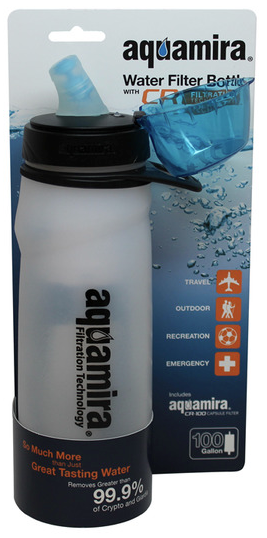 Below, I will try to translate all this microbiology/technical info into some practical recommendations: Hand-held (aka "scoop-and-go"), single person water filter bottles: a) Microfilters (will remove bacteria and protozoal parasites, but NOT viruses): Microfilters will remove bacteria and protozoal parasites (eg., cryptosporidium, giardia lamblia), but not viruses (except for one product listed below!). If you are going to be hiking in remote areas, and don't need anti-viral protection, then, consider these water filter bottles by KATADYN®, McNett, and Sawyer: • Aquamira by McNett: (pore size: doesn't apply) One example of a water bottle with a "depth"-style filter is Aquamira's water bottle shown here. Even though it was endorsed by National Geographic's Adventure magazine several years ago, and, according to McNett, their filter was certified to remove 99.9% (ie., the "nominal" removal rate) of Giardia and Cryptosporidium by Biological Consulting Services in North Florida, the other products listed below post more impressive removal rates and remove a broader spectrum of microbes. I could not find this water bottle on REI.com. You can purchase it directly from McNett.com for $29.95.
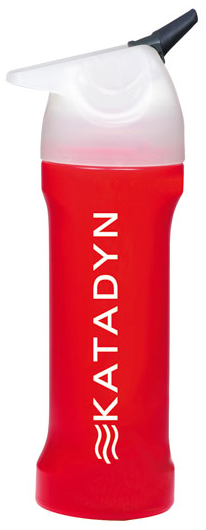 • KATADYN® MyBottle MICROFILTER (pore size: 0.2 micron): KATADYN® has been making microfilters for at least 15 years. They produce several different bottles, each with multiple types of sterilization. Some are microfilters and others are purifiers, but all are sold under the "MyBottle" product line. It appears that the purifiers are available in either blue or green bottles, while the microfilters are available as either red or white bottles. But, to be safe, look for the type (eg., microfilter or purifier), not the bottle color. Their "MyBottle MICROFILTER" is made from fiberglass, has a pore size of 0.2 microns, and contains activated charcoal. Note that the microfilter does NOT remove viruses.
• Sawyer "Zero Point ONE" (pore size: 0.1 micron): Sawyer appears to make high-quality products. I have to be honest, I am impressed by the removal rates Sawyer claims. 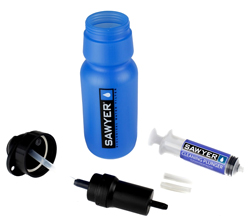 Sawyer makes 2 different filters: Their "Point ONE" filter (ie., containing a 0.1 micron filter) removes parasites and bacteria. Sawyer states that their U-shaped hollow fibers achieve an extremely high removal rate for parasites and bacteria, exceeding EPA standards. It does not remove viruses, however. To also guard against viral pathogens, you need to utilize their "Point Zero TWO" filter, which contains a 0.02 micron filter, though, this filter is not available as a scoop-and-go hand-held bottle. Sawyer's technology has been tested and verified by the United Nations and is used in more than 70 countries around the world. Sawyer's Water Treatment Filter Bottle ($49.95). Sawyer makes 2 different filters: Their "Point ONE" filter (ie., containing a 0.1 micron filter) removes parasites and bacteria. Sawyer states that their U-shaped hollow fibers achieve an extremely high removal rate for parasites and bacteria, exceeding EPA standards. It does not remove viruses, however. To also guard against viral pathogens, you need to utilize their "Point Zero TWO" filter, which contains a 0.02 micron filter, though, this filter is not available as a scoop-and-go hand-held bottle. Sawyer's technology has been tested and verified by the United Nations and is used in more than 70 countries around the world. Sawyer's Water Treatment Filter Bottle ($49.95).
b) Purifiers (WILL remove viruses, in addition to bacteria and protozoal parasites): Water filter bottles that remove viruses are referred to as purifiers. 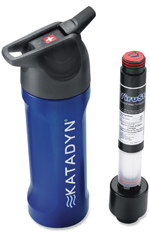 They achieve this either by a chemical process or by filtration. If you are going to be drinking ground water in heavily-populated areas (where there is a higher concern of viral pathogens), then the anti-viral "purification" step becomes important. They achieve this either by a chemical process or by filtration. If you are going to be drinking ground water in heavily-populated areas (where there is a higher concern of viral pathogens), then the anti-viral "purification" step becomes important. • KATADYN®'s MyBottle PURIFIER (pore size: 0.3 micron): The KATADYN® MyBottle Water PURIFIER ($59.95) appears to be a very high quality scoop-and-go product. As described above, it combines filtration + purification. It uses an iodine-based resin filter to remove viruses. On September 23, 2014, it was available at REI.com for $59.95.
One product has a small enough pore size to be able to filter out viruses without using a chemical-based system: •"Lifesaver" (pore size: 0.015 micron): For individual use, if you want what appears to be the best product on the market, you would be hard-pressed to do better than the LifeSaver. 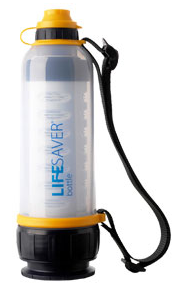 This personal-use water purification system boasts the highest removal rates, and claims to have the smallest filter pore size: 0.015 microns (= 15 nanometers). Note that this water filter bottle does NOT use chlorine or iodine, yet, claims to be able to remove viral pathogens. This personal-use water purification system boasts the highest removal rates, and claims to have the smallest filter pore size: 0.015 microns (= 15 nanometers). Note that this water filter bottle does NOT use chlorine or iodine, yet, claims to be able to remove viral pathogens. Their most dramatic claim is that it can eliminate the polio virus, which is 25 nanometers in size. They provide on their web site some laboratory test results backing up these claims. It meets the standards of the EPA and a slew of other ratings agencies. It has been on the market since 2007 and is used by military personnel around the world. Very impressive! Of course, this is the most expensive product I came across: Amazon.com sells their 4000 model for $163 and their 6000 model for $202 (as of 9/25/14). I could not find the LifeSaver on REI.com. If you want the top-of-the-line scoop-and-go product available and don't mind paying for it, then get the LifeSaver. However, for $50-60, it appears water filter bottles from KATADYN® and Sawyer would do just fine.
Pump style filters/purifiers: The hand-held water filter bottles described above are good for a single person. However, if you need to filter a larger quantity of ground water, then, the pump-style filters may be the way to go: 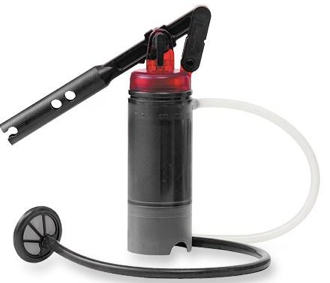 REI.com sells several models by MSR. Note that MSR offers a "Microfilter" model (protozoa, bacteria, $89.95) and a "Purifier" model (protozoa, bacteria, viruses, $99.95). The Purifier option contains a 0.2-micron filter and is claimed to remove 99.99% of waterborne protozoan parasites, bacteria, and viruses. DISCLAIMER: Other than the original Exstream Orinoco bottle, I have not personally used any of these products. And, so far, I have only read objective/laboratory test results for the LifeSaver product. However, I will search for performance data like this for the other products. Stay tuned..... There is more on water purification at my other review: "Hiking."
NAVIGATION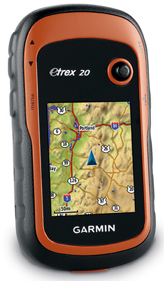 When it comes to GPS devices, Garmin is the big name here. Garmin's eTrex 20 ($199) seems to be a superb choice. Other brands to consider are Delorme, and Magellan. Consumer Reports reviewed GPS units in their December 2013 issue. However, there are over a million phone apps available so you could likely find an app that meets your needs, too.....assuming you can get cell phone service in the back woods. Another device that also uses GPS technology is: SPOT. This device is intended more for rescue than navigation, per se. But, what if your technology fails? Bring a compass and a map and brush up on how to use them. It's tough to beat the simple and easy-to-use Arrow-6 compass by Suunto ($55.95). Don't forget a flashlight or a head lamp. On second thought, bring both!
SURVIVAL GEAR 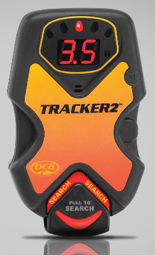 Have you heard of "Personal Locator Beacons"? You might want to give these devices some serious consideration, particularly if you like to hike alone. Leading manufacturers are: But, low-tech works, too. A mirror and a whistle are absolutely critical. In lieu of a mirror, a knife blade, a credit card, or even the aluminum foil from a gum wrapper might work to reflect sunlight and help someone find you. Also, worth considering: - a folding knife or a multi-tool
- 30-50-ft of rope
- several feet of duct tape
- a solar charger device
- a solar-powered or crank-powered weather radio
MEDICAL STUFF Bring at least some rudimentary supplies: • First-aid: Bring stuff you can use to clean and bandage a cut, MoleSkin and tape if you develop a blister, etc. • For gastroenteritis: If you are worried about the possibility of developing diarrhea from drinking contaminated water, then bring some Pepto-Bismol and loperamide. Many people don't realize how effective Pepto-Bismol is for bacterial causes of gastroenteritis. The active ingredient in Pepto-Bismol -- bismuth -- is most often used to prevent traveler's diarrhea, but it can also be effective for treatment (Steffen R. 1990). However, bismuth is not effective against giardia. Don't forget bug repellent containing Deet or Picaridin and sunblock. Several years ago, National Geographic's Adventure magazine recommended the skin protection products from Dermatone. Their "Lips & Face Protection Creme" reflects the entire spectrum of UV-A and UV-B rays, and prevents chapping and cracking of your lips. It contains no water, so, it won't freeze.
SOLAR CHARGERS A variety of types of solar chargers are now available. These can be used to charge up some of your devices. Generally, these solar chargers don't produce much current, so it takes all day to charge something.
SPARE PARTS Review what are the most critical things you will need and consider bringing a spare. For example, spare batteries for your head-light or flash-light, a spare mirror or spare whistle. Do you wear contact lenses? Bring an extra pair. Extras of these items will not add weight or take up much space but could make a huge difference in your safety.
CAMPING GEAR OK, you've completed the day's hike and now you're ready to relax. Here are some thoughts on what you'll need at your campsite: Fire: Matches, a lighter, a magnifying glass, and/or a sparking tool should be on your list. Keep the matches in a watertight container. Consider dipping the head of each match in wax to make it even more waterproof. Tents: There are so many types, brands, sizes, and features of tents, that is it impossible to summarize them here. My suggestion? Go to our Hiking Gear section to start your search. Another good resource is REI.com. Whether or not you bring a tent, bring a tarp. You can place it under your tent to help prevent moisture from seeping through, or, you can sleep directly on it. Or, use it as a cover to sleep under. Sleeping Bags: Sleeping bags range from $65 to over $500. This reflects quality and, also, how well insulated they are. When evaluating sleeping bags, consider: • Type of insulation - down vs. synthetic: It's tough to beat goose down feathers for insulation. Feathered Friends has been making sleeping bags using goose down since 1972. But, after many years, feathers may compress. • Minimum temperature rating: For the average weekend hiker, who doesn't sleep outside when it's really cold, the vast majority of sleeping bags will keep you warm. However, if you know you'll be at high altitudes and that it will be quite cold, then give careful consideration to the temperature range of any bag you buy. • Hood vs. no hood: I have 2 bags: one with a hood and one without. I once read a story about a guy who awoke with a snake inside his bag. It had crawled inside his bag during the night to stay warm. He had to lie there for several hours in the morning, until the sun warmed things up. Then, the snake decided it was getting too hot, so it slithered out. So, when I sleep under the stars, I use the bag with the hood. I pull the hood over my head, then pull the drawstring tight, leaving only my face exposed. To keep bugs from crawling in my mouth when I'm asleep, I also wear a mosquito net over my head. In 2014, Backpacking-Guide.com recommended the best sleeping bags in 10 categories:
| BEST: | MANUFACTURER | MODEL | | • For Winter: | Sherpa
Adventure Gear | Pertemba | | • For Summer: | Sierra Designs | Nitro 30 | | • For 3 Seasons: | Exped | Woodpecker | | • Down Bag: | Marmot | Lithium | | • Synthetic Bag: | Mountain Hardwear | Ultralamina | | • Ultralight Bag: | Feathered Friends | Hummingbird Nano | | • For Women: | REI | Kilo Flash | | • For Couples: | Functional Design | Sweetie Pie
Doubler | | • For Kids: | The North Face | Tigger | | • Under $200: | The North Face | Cat's Meow |
Sleeping Pads: These things aren't heavy to carry on your hike and they can make sleeping on a hard surface more bearable. I have one with a foam core that can also be inflated for additional cushioning. Fun Stuff: Bring a smart phone. Even if you can't obtain wireless access, you can take lots of pictures. A Frisbee, a deck of cards, a harmonica, a crank-powered radio, a journal to take notes, are other fun things to consider.
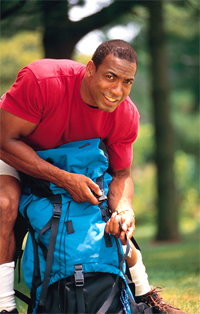
HOW MUCH DOES ALL THIS WEIGH?!! Now, for the hard part: what to leave behind? Once your backpack gets up to 30-35 lbs, each additional pound really makes a difference. Don't forget that you'll likely also be bringing food so, consider those items when you weigh your backpack. So, think about what you absolutely need. Do you really need that thick book? And while it's great to have a camera on a hike, a tripod and extra lenses can add a lot of weight. Liquids add a huge amount of weight. Each gallon of water weighs 8.4 lbs. Can you filter/purify water instead of carrying it? Instead of a butane tank and a stove, can you make a fire safely and reliably? Try to think of multi-use items, instead of separate single-use items. For example, bring a multi-tool instead of a knife and several other separate utensils. Instead of a tent, can you use your trekking poles and a tarp?
FOR MORE INFORMATION Most of these products can be purchased from REI.com. Readers may also be interested in the following stories:
EXPERT HEALTH and FITNESS COACHING Stan Reents, PharmD, is available to speak on a variety of exercise-related topics. (Here is a downloadable recording of one of his Health Talks.) He also provides a one-on-one Health Coaching Service. Contact him through the Contact Us page. DISCLOSURE: Neither the author, nor AthleteInMe, LLC, has any affiliations with any of the products mentioned in this review.
REFERENCES Donachie P, Krahn J. "Report on Microbiological Tests Carried Out For LifeSaver Systems," London School of Hygiene & Tropical Medicine, London, December 17, 2007. Mandell GL, Douglas RG, Bennett JE, eds. Principles and Practice of Infectious Disease, 3rd ed., 1990, pp. 2110-2115. "Microfilter, Purifier, or Chemical Treatment?", a PDF document from www.Katadyn.com (accessed September 22, 2014). "Micron Ratings and Water Filters: Aquamira Sets the Record Straight", February 22, 2013, from www.McNett.com (accessed September 22, 2014). Reese RE, Betts RF. A Practical Approach to Infectious Diseases, 3rd ed., 1991, pp. 312, 320-321, 653-655. Steffen R. Worldwide efficacy of bismuth subsalicylate in the treatment of travelers' diarrhea. Rev Infect Disease 1990;12 Suppl 1:S80-S86. Abstract "Water Filtration - Sawyer Water Filter Technology," Sawyer.com (accessed September 25, 2014). ABOUT THE AUTHOR 
Stan Reents, PharmD, is a former healthcare professional. He is a member of the American College of Lifestyle Medicine (ACLM) and a member of the American College of Sports Medicine (ACSM). In the past, he has been certified as a Health Fitness Specialist by ACSM, as a Certified Health Coach by ACE, as a Personal Trainer by ACE, and as a tennis coach by USTA. He is the author of Sport and Exercise Pharmacology (published by Human Kinetics) and has written for Runner's World magazine, Senior Softball USA, Training and Conditioning and other fitness publications.
Browse By Topic:
exercise equipment, fitness gear, green exercise, hiking gear
Copyright ©2025 AthleteInMe,
LLC. All rights reserved.
|